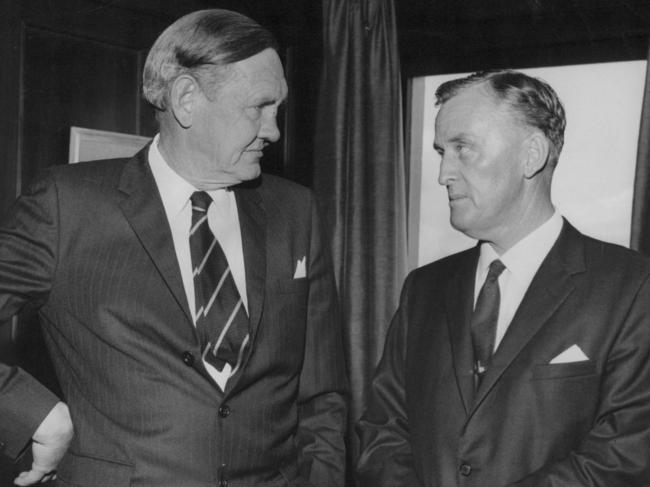Victorian Liberal and National party coalition re-examined
Victoria’s Liberal and National parties have been like veteran Hollywood stars — breaking up and making up over the decades. What will they look like in 2023?
With smashed cheekbones and a disfigured nose sustained from war, John Gorton wasn’t too worried about saving face, politically speaking.
The Kerang region farmer addressed his fellow Country Party members at their annual conference, only a few short years after World War II.
Gorton’s message wasn’t welcomed by delegates.
The future prime minister called for the Country Party to merge with the newly-formed Victorian Liberal Party, uniting forces against a resurgent Labor under the leadership of John Cain senior.

According to Gorton’s biographer Ian Hancock, the Liberal-Country merger proposal was voted down an incredible 800 votes to a solitary ballot.
Utterly defeated, Gorton decided to leave the Country Party. The following year he was elected a Liberal senator, the start of a two-decade journey towards The Lodge.
“The relationship between the Libs and the Nats in Victoria is like Elizabeth Taylor and Richard Burton,” a former Nats MP told The Weekly Times.
“Remember them? Whenever they made movies together, they had a big hit. But it’s a volatile relationship. You’re always falling in and out of love.”
Just like the love extended by regular voters at the ballot box.
Government seems a long way off for both parties after the 2022 Victorian election.
While National Party leader Peter Walsh hailed the 2022 results as big wins for the Nats, drill down on the primary vote statewide and the picture is more nuanced.
Last month, the Victorian Liberal Party achieved a statewide primary in the Legislative Assembly of 29.8 per cent, with the Nats on 4.9 per cent.
Contrast that to the Victorian Coalition’s finest hour – the 1992 landslide.
The 1992 Libs boasted a primary of more than 44 per cent while the 1992 Nats enjoyed a lower house primary of 7.8 per cent.
Former deputy prime minister John Anderson was part of one of Australia’s most successful coalition governments, state or federal.
While NSW-based, Mr Anderson told The Weekly Times that Victoria’s two centre-right parties needed to seriously rethink their respective strategies in the coming four years.
“The Liberal Party in Victoria in part needs to do some soul searching first because I’m not quite sure what they stand for,” the former federal Nats leader said.
“And I think that’s the problem in the electorate. You have to know what it is you stand for, there was far too much me-tooism, those issues need to be resolved before you talk about future coalition agreement.”
Despite the 2022 drubbing, the Liberal-National relationship has been far stronger in the past decade than in previous generations.
The first coalition immediately after World War II, when a young John Gorton implored greater co-operation, was turbulent.
Ballarat lawyer Tom Hollway and Shepparton farmer John McDonald led the Liberals and what was then known as the Country Party in the late ‘40s and early ‘50s.
The two leaders attempted to work as premier and deputy premier but the coalition soured.

Only two years later, McNamara’s Nats were in power under Jeff Kennett.
The Kennett revolution eroded support for the Nats in regional Victoria, leading to new leader Peter Ryan tearing up the agreement shortly after replacing McNamara as leader in December 1999. Ryan even rebranded the party as the ‘VicNats.’
The day after the 2022 election last month, Gippsland South MP Danny O’Brien floated the idea of another split (although he didn’t explicitly call for a coalition divorce).
Mr Walsh immediately slapped down the suggestion.
Victorian National Party president Neil Pankhurst said his party and the Liberals needed each other to form government.
“A split in the Coalition means always being in opposition. We need a coalition in order to form government,” Mr Pankhurst said.
“There’s no appetite among the grassroots Nats (for a split). It wouldn’t achieve much and the next few years needs to be focused on rebuilding. Our party had a great result (in 2022), we need to build on that success).”
Victorian Liberal president Greg Mirabella echoed Mr Pankhurst’s call.
“It’s not in the political or financial interests of either party. No one is seriously talking about a split,” he said.
“If anything, there’s talk about greater co-operation. The three-cornered contests are expensive and campaigning (negatively between Libs and Nats) isn’t productive for either side.”

Mr Mirabella said any discussion of a Queensland-style fusion of the conservative side of Victorian politics also was not on the table.
Former Liberal Party president Joy Howley said all major parties had to battle for volunteers and supporters, with a split on the centre-right exacerbating existing electoral fragmentation.
Victorian Labor is not immune from the voter drift from major parties.
The 1992 election is considered a low water mark for the Victorian Labor Party. But 1992 Labor under Joan Kirner received a lower house primary of more than 38.4 per cent.
By contrast, the 2022 Danslide result produced a Labor primary vote in the Legislative Assembly of 37.1 per cent.
“Certainly, when the Liberal and National parties have worked in coalition, it has been far more successful electorally,” Mrs Howley said.
“The electoral equation is clear: in order to form government, the Liberal and National parties need each other.”




